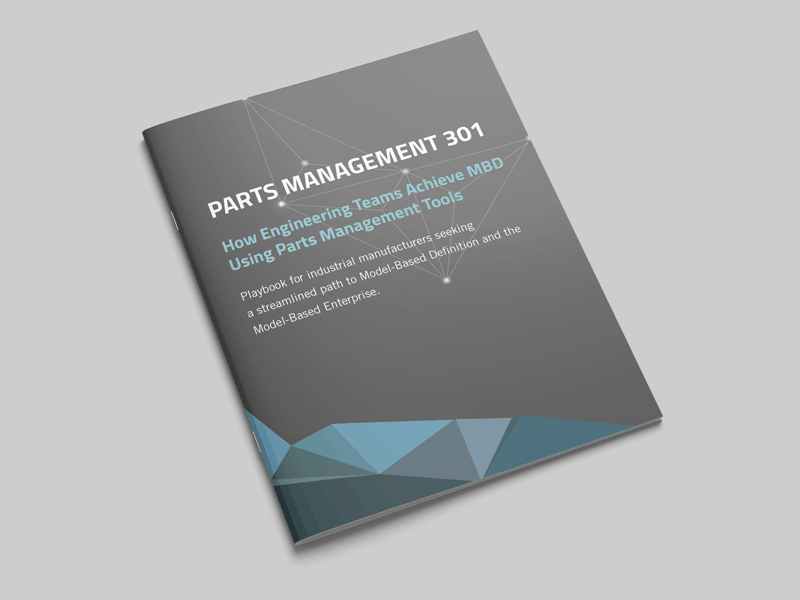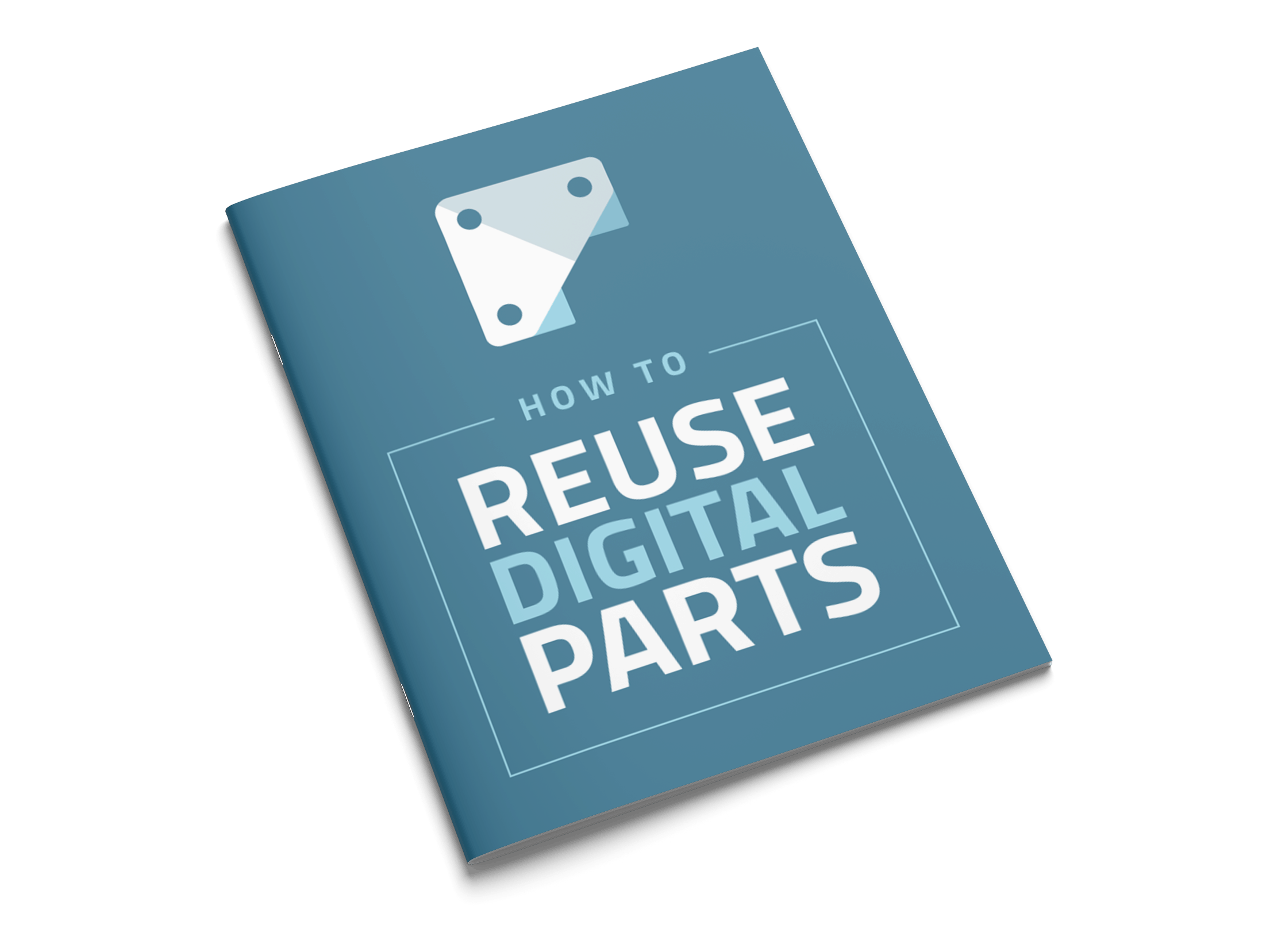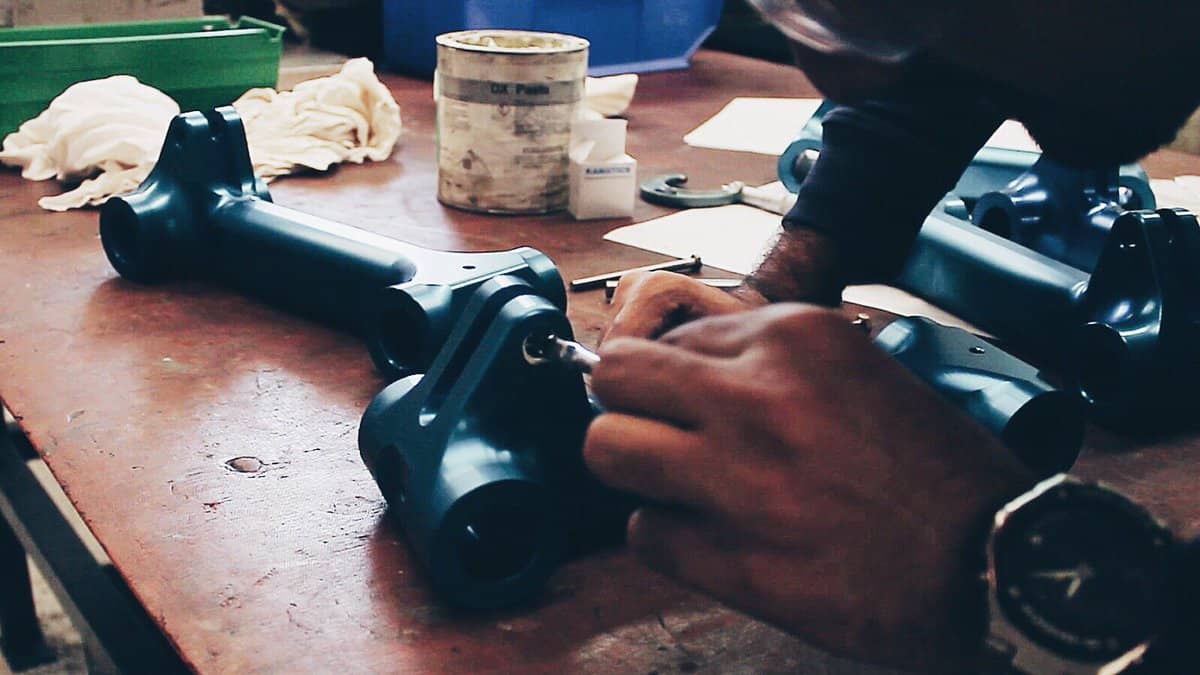How to Reuse Parts to Increase Your Engineering Efficiency
July 15, 2021 – 30 min read time – Get the eBook Version
A Comprehensive Guide to CAD Reuse and Part Standardization
Most engineers don’t go to school so they can model screws and brackets. They pursue a career in engineering so they can create innovative products and solve complex problems. And yet, much engineering time is spent creating CAD models of generic parts.
The truth is custom-designed parts are not always better. Not every part is worth designing from scratch.
Let’s be honest, is modeling fasteners and clamps a good use of engineering expertise? Of course not!
Does modeling a bracket or a bearing make a design better? No!
The reality is by using more standard parts, engineers free up time to create innovative solutions that make the world better.
Here’s what you will learn about in this article:
- The three types of standard parts
- How part reuse revolutionizes engineering efficiency
- The 5-pillars of The Reuse Method
This article will take about 30-minutes to read. If you prefer reading an eBook, we’ve got you covered! Get the eBook version of this article delivered to your inbox for future reference.
Standard Parts
A standard part is any part that can be reused or “standardized” across an assembly or multiple assemblies. Standard parts include fasteners, brackets, cylinders, or even entire assemblies of parts. Broadening the use of standard parts and their applications will skyrockets design speed and efficiency for engineers. Standard parts are versatile “building blocks” for quickly assembling new designs.
Types of Standard Parts
Many engineers think of “standards” as industry-standard fasteners; but in reality, there are three types of standard parts for most engineering teams. Understanding these types of standard parts is the basis for engineering reuse.

The three types of standard parts are:
- Industry Standard Parts
- Commercial Standard Parts
- Company Standard Parts
Each of the three types of standard parts has a unique role in facilitating a part reuse strategy.
Industry standards are part specifications mandated or preferred in specific industries. Industry Standard Parts are components regulated by a standards body. These parts meet standards that are tested for quality, reliability, and safety.
For instance, Department of Defense projects are usually regulated by military MIL-SPEC specifications or other military standards. Regulated parts are inspected for conformance by U.S. Government standards bodies.

Standards 3D catalogs are an authoritative digital representation of physical-industry standard parts. For example, AIA NAS standards catalogs are used in the aerospace industry. SAE standards catalogs represent automotive and aerospace parts. Other industries have various industry standards they follow as well.
Commercial Standard Parts or COTS
Most engineering projects contain “standard” parts purchased from suppliers. These parts are often called commercial standard parts, supplier standard parts, or COTS (commercial off-the-shelf) parts. Engineers use commercial standard parts alongside the parts they design within their CAD program. These commercial standard parts are sourced from a manufacturer. Common commercial standard parts include fasteners, brackets, bearings, motors, cylinders, connectors, and more.

Commercial standard parts are often found in part catalogs. Part catalogs are a list of parts and specifications available from a particular manufacturer or distributor. Traditionally catalogs were physical, but today digital catalogs are essential for manufacturers to offer on their website too. Sometimes the catalog contains spec sheets with specific part specifications, and others offer 3D CAD models for engineers to download.
Engineers play a crucial role in identifying which parts should come from a manufacturer or supplier and which ones should be designed and manufactured internally. When engineers purposefully design-in more commercial standard parts, it saves time and resources—the savings compound when the supplier offers configurable CAD models that contain the appropriate metadata for use downstream from engineering.
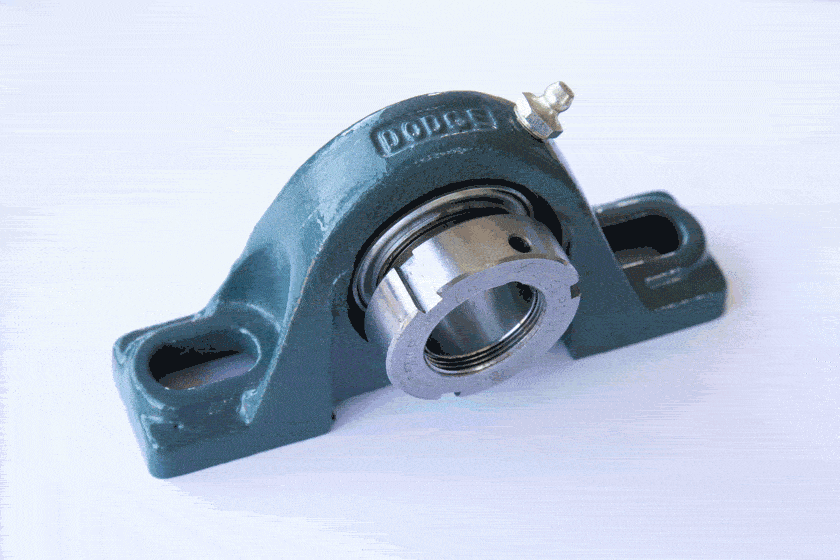
Company Standard Parts
Company standard parts are internal designs specifically marked for reuse. Some companies have an extensive library of internally created parts from past projects; for these parts to be considered “standard parts,” they need to be reusable across multiple designs and categorized for reuse.
Reusing or repurposing company standard parts multiplies the effective use of a company’s intellectual property. It’s an effective way to harness the power and resources from previous projects for new applications. Using company standard parts is one of the easiest ways to accelerate design time, cut redundant documentation, and decrease direct material spend within engineering and procurement departments.

Thinking in Standard Parts
Most design engineers spend time every day creating or redrawing parts that already exist, either internally or from a supplier.
If a part, especially a preapproved part already exists, why recreate it? It’s clearly a waste of resources for several engineers to create or source identical parts, but it happens all the time.
Thinking in standard parts is a mindset change that frees up time for engineers to create innovative designs instead of redoing work someone else has already done
To think in standard parts requires a sharp deviation from traditional engineering processes. These processes were originally created with drafting tables and pencil drawings in mind, not the advanced 3D CAD tools available to design engineers today.
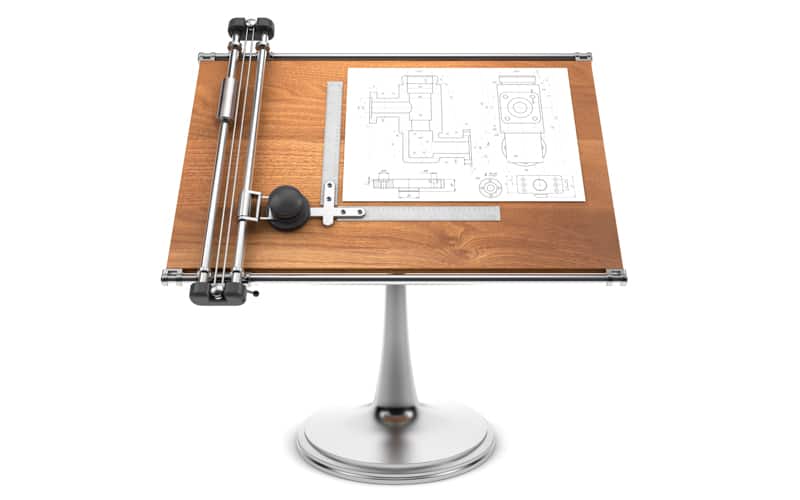
Starting a Project Off Right
When a project starts, design engineers are tasked with designing specific functionality into the final assembly for the project. There are parameters they must adhere to within the project scope. Typically they start by addressing the main functionality of the design. After figuring out how to create the core functionality, they design custom parts and use industry-standard and commercial parts to fill in the gaps.
Thinking in standard parts is a slightly different approach. It starts with the reuse of standard parts built into the project from the beginning. Specific reuse parameters are determined upfront. By strategically using standard parts on the front end, engineering teams can save hours of work and material spend on the back end.
In other words, use standard parts wherever possible. Only after using as many standard parts as possible should engineers create new parts to add maximum functionality and innovation.
Here’s a question engineering teams can ask at the start of a project:
“Are there parts we’ve created in the past or commercial standard parts that can be reused or modified for this project?”
The parts you decide to reuse become parameters from the start of the design.
Engineering teams must determine which parts will bring the most value through innovative design and new part creation during the design process. This puts critical engineering expertise to use where it brings significant value. If designing a new part doesn’t add value, engineers should use a standard part instead.
The value from reuse for engineering teams is only the tip of the cost reduction iceberg. The majority of the benefits of reuse are for departments and processes downstream from engineering. Every time a part is reused, it cuts hours in the part approval, testing & analysis, supply chain, and maintenance processes, to name a few.
LEGO Illustrates Thinking in Standard Parts Perfectly
Thinking in standard parts is a familiar concept for those of us who played with LEGOs as a kid. Almost all LEGO sets consist entirely of standard or repurposed parts.

LEGO doesn’t mold a new block for every set. Instead, there are standard parts LEGO uses in every single design. For each of the primary LEGO bricks, there are many variations. These variations of the standard blocks are modified for reuse in specific applications rather than being completely redesigned with each new set.
Which is faster, building a design out of LEGO bricks or designing and 3D printing individual parts and putting them together? Both designs can accomplish the same goal. The 3D printed parts may look different, but are the improved functionality and aesthetics worth the extra time? Not always.
Imagine building 50%-70% of a design out of LEGOs, then modeling and 3D printing the most innovative parts from scratch. In this case, you get the best of both worlds—a unique, innovative design faster and at a lower cost.

Part Reuse
Thinking in standard parts makes it easier to reuse parts engineering teams created or sourced in the past.
Every new part an engineer introduces is a potential reuse candidate for future projects. Once a project is complete the parts that made it into the final design are already approved and downstream processes complete. Why not make everyone’s job easier by reusing parts with sunk costs already covered?
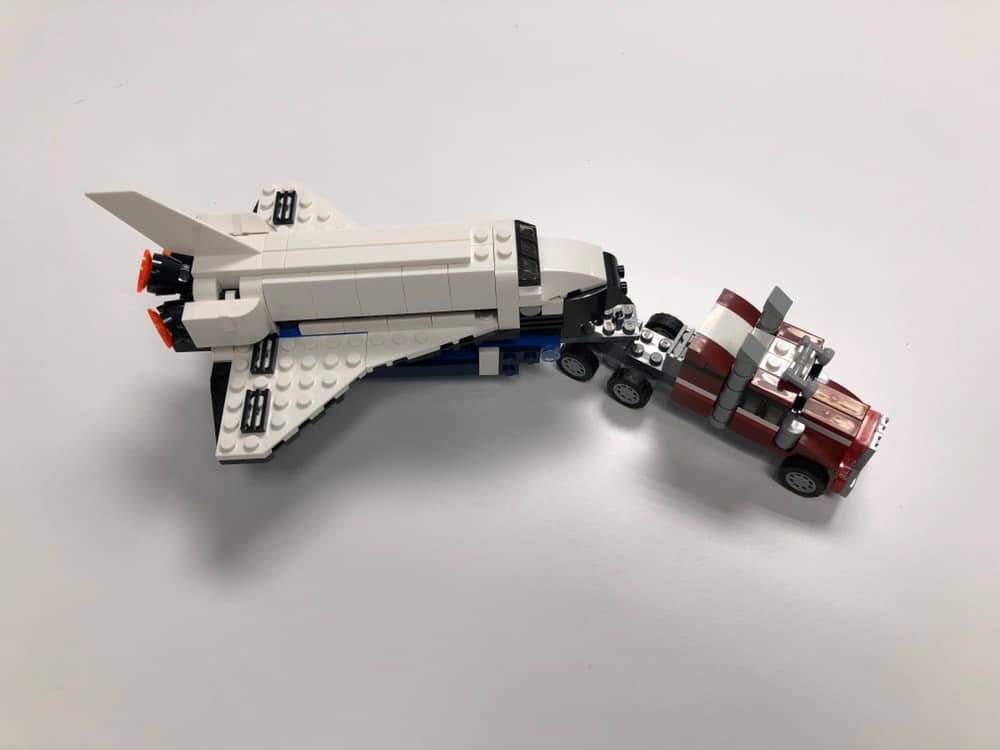
The LEGO Philosophy
LEGO’s philosophy is built on standard part reuse. The LEGO CREATOR line offers multiple different designs from the same set of parts. The instructions include designs for 2-3 completely different models from a single set of parts.
When an entire engineering team adopts the LEGO philosophy of thinking in standard parts, the benefits of reuse multiply. Instead of each engineer sourcing similar parts from different suppliers, they can standardize select common parts across the whole team. The work of one engineer benefits the entire engineering department. One standard part can be in use across multiple assemblies and projects when intentionally categorized for reuse.
Engineers can also design a part for future reuse by configuring the design to fit several applications. Now, let’s apply this concept to an L-bracket.
When designing an L-bracket, engineers can include several mounting configurations within the same part. As a result, the bracket will now be useful within different assemblies with varying mounting needs.

Engineers must plan ahead to make sure the standard L bracket will work in their designs, but they will save time and resources by reusing this “standard” component. Not wasting time searching for, redrawing, or creating a part is an excellent way for engineers to improve productivity. Part reuse not only saves time, but it also saves resources throughout the product life-cycle from the supply chain to manufacturing and maintenance of the physical product.
An engineer’s real-world LEGOs are fasteners, brackets, motors, cylinders, just to name a few. Some progressive companies reuse complex assemblies as standard parts for various projects as well.
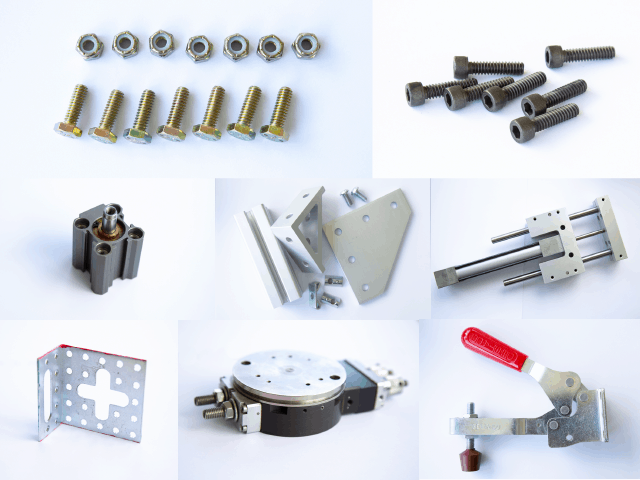
Part Reuse in the Real World
A Global 500 Airplane Manufacturer
We worked with a global airplane manufacturer to assist them in implementing a company-wide bracket standardization and reuse process. By focusing on reuse, they reduced the number of brackets used in their assemblies by 850 parts.
By Enabling 5,000 users to reuse brackets, they were able to save $1.42M on brackets alone. Now those 5,000 users can focus on designing a better plane instead of redrawing brackets. The buying team can concentrate on getting the best pricing vs. sourcing 850 different brackets.
And that is just brackets: not screws, bearings, motors, or more complex assembly parts.

The Ryerson University International Hyperloop Team
Elon Musk introduced the idea of a Hyperloop transportation system in 2013. SpaceX put on the Hyperloop competition to encourage innovative solutions for the concept.
The Ryerson University International Hyperloop Team went to the SpaceX competition in 2016. Their focus was on creating landing gear for the Hyperloop Pod.
The team created and tested five systems in less than 1-year. They were able to accomplish this by thinking in standard parts and utilizing the majority of the parts in their design from AIA Standards and manufacturer components. In fact, out of the 204 parts used in the landing gear, 160 were standard “off-the-shelf” parts.
Thinking in standard parts allowed the team to stay agile. They won the Subsystems Innovation Award at the SpaceX Hyperloop competition in 2016 for their landing gear design. Ryerson’s team created a better solution than their competitors who had more resources.
The parts for the landing gear design can be sourced and manufactured cost-effectively because of the use of standard parts. Most of the standard parts, 120, were AIA/NAS parts, which are industry standard parts.
The Ryerson Hyperloop team is an example of how a reuse strategy helped them do more with less.
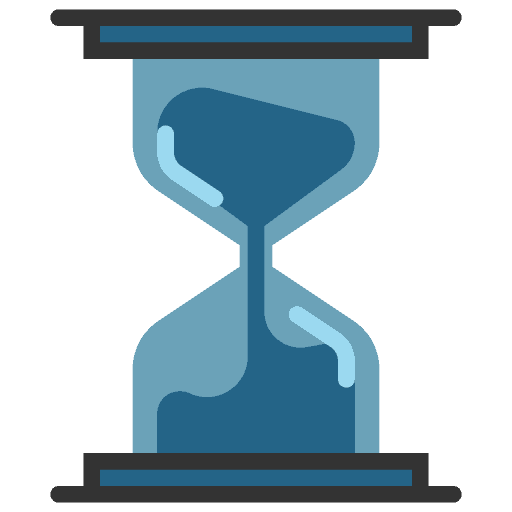
How Part Reuse Saves Time
In some projects, there are duplicates of the same part within a single assembly. It happens because a part is entered into a company database multiple times under different names. Sometimes the same part is in the system with a different name dozens of times. Every new part placed in an assembly takes time to source or draw and manufacture. It also consumes company resources in every phase of the product life-cycle.
In a survey of over 500 manufacturing companies, engineers said they each spend roughly two hours per day sourcing and redrawing supplier parts. That’s equal to 59 days of innovation and problem solving lost to mundane non-value-added work per engineer each year!
The Department of Defense conducted in-depth research on parts management. The Parts Standardization and Management Committee published the results in a paper called: Reducing Program Costs (RPC) Through Parts Management.
We will reference this study as RPC.
RPC Findings
The RPC report says that it takes 6 hours on average to search for every new part entered into a data management system. For every hour spent searching for a part, it takes ten additional hours to document the part. Engineering design and documentation is only 46% of the total cost of introducing and maintaining a new part. (RPC Pg. 11-12)
DoD regulations add extra documentation to be sure, which the average company may not have to deal with. If a typical company requires 10% of the DoD’s documentation, it’s still one hour of documenting for each hour of part search time.
Every part introduced into an assembly must be approved, entered into a data management system, and documented. In some cases, there are 2D drawings created for manufacturing or for a sourcing department to assist in the procurement process. Design engineers are not responsible for all documentation steps. However, documentation is an important and time-consuming step in the engineering process that is often overlooked when calculating the costs of introducing a new part.

Getting to a 6 Hour Part Search Time
Many engineers will scoff at the idea of spending 6-hours searching for a part. For certain industries and parts, this may seem like a high number. In reality, there often overlooked that search-creep occurs.
After an engineers determines a new part is required for an assembly, they must determine the correct attributes and requirements for the part. Then they must track down where to find the part, which manufacturers provide acceptable components, and differences between similar components. Finally, engineers acquire the correct part file or request it, then import it into their CAD system and place it in the assembly.
The search process isn’t necessarily complete when the part is inserted into an engineer’s CAD assembly. The engineers must ensure the part fits and works as desired and the part must be approved by the engineering manager. If the part doesn’t fit or isn’t approved, then the process starts all over.
Sometimes the part will be rejected downstream in the supply chain department, purchasing, or manufacturing which starts the part search back over.
Often, engineers redraw parts they already have to fit the specific application they need due to the lack of fidelity in the CAD model. For example, if an engineer downloads a clamp from a supplier’s website in a neutral CAD format with a fixed 90-degree angle, it may need to be modified or redrawn for an application that requires a 45-degree clamping angle.
Sometimes the downloaded files don’t import well into the designer’s CAD program and need to be repaired. This process can take hours depending on the part.
If a part needs to be redrawn, it can add hours to the search process. Engineers often think of search time in terms of how long it takes to find the part initially. However, when all factors are considered, including redrawing and repairing parts, it usually takes more time than engineers estimate. Parts like simple fasteners may only take a few minutes to find, redraw, or fix, but complex parts could take days to find the right part.
Regardless of whether it takes one hour on average, or 6-hours on average to find a part, it is non-value-added time. Searching for, repairing, and redrawing parts slow down the design process, reduce the quality of the final assembly, and increase the cost of the engineering phase.
Part Reuse Time Saving Example
Reuse parts saves time.
Let’s set the stage for an example. We’ll, on average, it takes half the time the RPC says it takes to search for a part. Let’s also assume the documentation takes 10% of the time shown in RPC.
In this example, every new part entered by an engineer into a file management system will take six engineering hours total between part search and documentation. That’s three hours to search for the part and 3 hours to document the part. Those hours are not limited to the initial search time, but instead are tallied through the life of a project
Six hours on average per each new part is 75% of a day’s work for every new part. To give an idea of how much time saving this scenario equates to, let’s look at a 400-part assembly. If thinking in standard parts helps an engineering team reuse 10% of the necessary parts for the assembly (40 fewer new parts added), it will save 240 engineering hours on a 400-part project.

Will 240 engineering hours or six workweeks improve a 400-part design? Absolutely.
Is delivering a project six weeks ahead of schedule a benefit for most organizations? Sure thing.
What if engineers could spend an additional three engineering weeks on innovation and function, cut project sourcing costs, and finish three weeks ahead of schedule? Sounds like a promotion is in order!
10% Reuse is Conservative
Basing the estimate on 10% reuse is a conservative number in many industries. One manufacturer we work with reuses 70% commercial off-the-shelf parts in some of their designs. In the same 400-part assembly, 70% reuse would be 280 reused standard parts; at 6-hours per part, they’re saving 1,680 total engineering hours. That is 42-weeks of time savings or nearly 10-months.
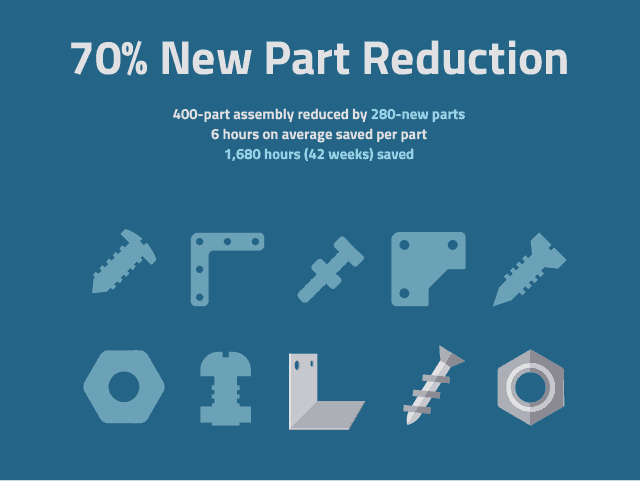
Engineering departments in large organizations are often siloed, which leads to engineers being unaware of the process after a project leaves their desk. It isn’t only the time spent drawing a part that adds costs and company resources; there are other costs as well. There is part design, but the part also needs to be approved, tested, and documented. Someone has to source the physical part or manufacture it. There are costs to keeping a physical part in inventory after it is manufactured and logistical costs as well.
By standardizing parts for reuse, a Fortune 100 manufacturer was able to cut their purchased part count by 25%. That is no small feat considering thousands of engineers access their systems and use millions of parts every year.
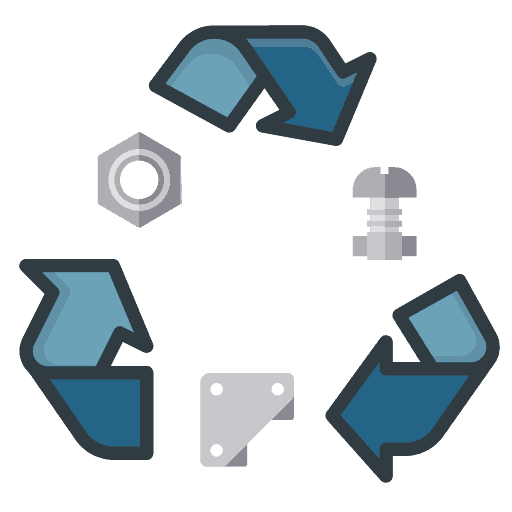
The Reuse Method
The Reuse Method is a framework for effectively managing standard parts for reuse. The methodology contains five pillars for increasing productivity, efficiency, and reducing costs. By embracing The Reuse Method, engineers spend more time on innovation and problem solving, and less time reinventing the wheel and other non-value-added work.
The Reuse Method enables a digital thread (important data passing between departments and on to vendors/manufacturing).
The 5-Pillars of The Reuse Method:
- Measuring and Data Collection
- Thinking in Standard Parts
- Implementing a Standard Part Process
- Creating a Culture of Reuse
- Managing Standard Parts Effectively

Pillar 1: Measuring and Data Collection
Collecting information and data is the first step to plan out a reuse strategy. Effective reuse requires upfront work but will save time over the life of a project. A working group must establish the full cost per part through the product lifecycle to determine the financial benefit of a comprehensive reuse strategy.
These factors all affect the total cost of introducing and new part:
- Engineering time for new parts
- Engineering parts for finding and redrawing parts
- The part approval process
- Testing of parts
- Make vs. buy analysis
- Whether MBD practices are in place or 2D drawings are required
- What the procurement process is for purchased parts
- What the sourcing process entails for manufactured part materials
- The manufacturing process – Tooling purchase – CNC/CAM programming
- Lead time for new parts vs. purchased parts vs. reused parts
- Logistics involved in acquiring new parts
- Storage costs for additional parts
- Maintenance and service implications for products in the field
- Costs of maintaining a larger supplier base
Having a “before and after” snapshot is helpful for analysis, but it is also a handy tool to present to leadership for executive buy-in. Talk is cheap. But a data-driven analysis isn’t easily dismissed.
It’s also important to determine how long it takes engineers to create, find, or redraw parts with the current workflows. In addition, the feasibility of creating standard parts for reuse is vital during this stage of the process as well.
Pillar 2: How to Think in Standard Parts
We covered the concept of thinking in standard parts. Now let’s address some practical tips for how to think in standard parts as part of a regular engineering process.
The first step is to establish as a team the parts that can be reused within existing PDM or PLM systems. Engineers must start communicate with their team when they create a part that has the potential for reuse by other engineers. If so, a process must be established for categorizing and finding that part in the future. (We address this issue later on in the guide)

When starting a new assembly, engineering teams should ask the following questions:
- How can we use more standard parts or reuse parts we already have in our system?
- Are there similar assemblies that have parts we can reuse or repurpose for this assembly?
- How can we design this assembly with part reuse in mind for future assemblies or applications?
- How can we modify this design to reuse more screws, brackets, bearings, or similar simple parts?
When designing new parts engineering teams should ask the following questions:
- Is this part unique enough to require a new part?
- Will designing a new part or reconfiguring an existing part add value to the final design?
- Will an industry-standard part or a supplier part work for this application?
- Is there already a part in our system that can be reused?
- Is there a part in our system that can be reconfigured for this application?
- Can we use a company standard part for this application?
- Can we modify a company standard part for this application?
- If no, is there a way to change the design to use a standard part?
- Is designing a new part for this application rather than reusing or reconfiguring an existing part worth the hours it will take to design a new part from scratch when calculating all of the downstream cost and time implications?

Pillar 3: Implementing a Standard Parts Process
Every company requires a slightly different standard part process. But the underlying foundation is set by putting protocols and governance in place to manage the introduction and reuse of parts. These steps ensure each department is making the best part sourcing decisions.
Standard part processes are best when initiated with a small, focused team of engineers. Once the test group has ironed out the process, the strategy and tools are rolled out to other engineering teams throughout the company.
The next step is to implement the standard parts process and accountability across departments. Standardization will help the buying/procurement/sourcing departments communicate with the engineering department more effectively. When all departments align around standard part reuse, the best possible pricing and greater buying power are within reach.
A standard parts process helps procurement and supply chain management (SCM) understand the decisions engineers make. They can help engineers cut costs and get products to market faster by ensuring they have the best parts available to them.

Pillar 4: Creating a Culture of Reuse
The value of The Reuse Method can be seen on an individual basis, but the real value comes when an entire team, and eventually an entire enterprise, adopt the practice. The savings compound with each user who is actively reusing parts and sourcing parts effectively.
Individual engineers can kickstart the process by adopting standard part practices themselves. Once they can show the results, they can bring standard parts practices to their team.
From their, it’s helpful to have an executive champion within the company to continue driving the initiative enterprise-wide.
Driving Change
Getting people to change the way they do their job isn’t easy. There is an entire field of study around change management, and it can get tricky. The best way to get people to change is to show them proof of the results from the changes on a small scale.
There are engineers out there who are afraid of change. The industry is changing at a rapid pace, and change isn’t only smart business, but it is imperative for any company’s long-term success. Engineers that grow their skillset and help bring designs to the market faster with fewer resources will stay relevant as innovation pushes the field into the future.
Bring change by showing results
By using the data gathered from the previous pillars internal champions of the reuse strategy can show their immediate team the value of implementing The Reuse Method. It’s important to keep a record of the time saved and the improvements made to designs as a result of The Reuse Method. Having written data will make it easier for reuse champions to introduce the process to coworkers, managers, and leadership.
Let the numbers do the heavy lifting. It will take a while to get naysayers to buy into the benefits of reuse, but the data and results will ultimately help drive the initiative forward and help instill a culture of reuse.

Pillar 5: Managing Standard Parts Effectively
Thinking in standard parts and implementing a part reuse strategy is only possible if CAD files are managed with precision. If a CAD file can’t be located throughout the product lifecycle, there is no time savings or cost reduction.
There are different options and techniques available for managing files. We will cover a few techniques and file management systems in this section.
Classification
Classification is categorizing and storing digital parts based on their attributes. The same part can be classified based on several different attributes at the same time.
Think of classification like the Dewey Decimal Classification System at the library. It’s an effective way to manage data inside a file system or database.
Starting a classification project? Ask these three questions first.
Folder Management and Naming Conventions
Classification requires a consistent file management process. Straying from these practices will impede the reuse of parts through classification. These two essential classification techniques will help engineers find parts faster.
- Folder Management
- Naming Conventions
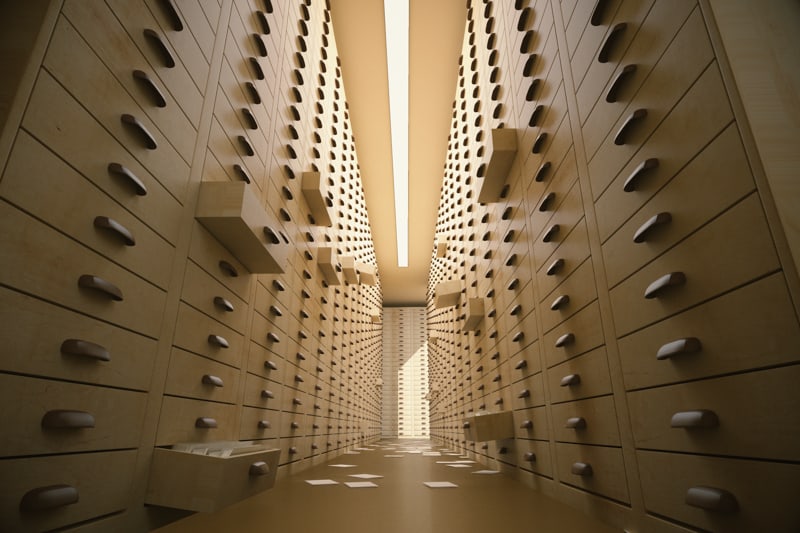
Folder Management
Folder management starts with creating a hierarchy of folders based on either previous projects or types of parts. It’s important to determine what makes the most sense within a particular data storage environment.
Once a folder structure is nailed down, it’s time to create the folders and start arranging CAD files. When old CAD files are in the correct hierarchy, it’s vital to create a governance and approval process for future file introduction.
Even if working alone, use a checklist to ensure parts are classified into the right folders. Using a checklist makes accessing files easy down the road.
Naming Conventions
Equally as crucial as folder management is creating a logical naming convention. You need to create a naming convention that will help easily find and reuse parts.
If you have more than one engineer, it is vital every engineer is using the same naming convention. If not, each engineer might download the same part from different suppliers for the same assembly.

Digital Part File Storage
CAD files need a home. Here are a few suggestions based on company size. There are several ways to store files, which we will cover in this section.
Local File Storage
Small companies specializing in simple products can manage CAD files locally. To do this effectively, a good folder system is a must! Create a folder structure to help engineers find parts for reuse. Naming structures and conventions live inside the local storage folders.
When several engineers work on a project or assemblies are complex, they require a better way to manage files like a PDM system. For large assemblies and long projects, organizations may implement a PLM system as well.
PDM
PDM or Product Data Management systems manage part and product data. It is a file system for storing important data about parts a company uses. These files are stored locally or in a cloud system. A PDM helps manage the files, allows for permissions, and sets protocols for approval processes.
When several engineers work on complex assemblies, PDMs are critical. It ensures engineers are using the right parts and are storing and managing CAD files correctly.
PLM
PLM or Product Lifecycle Management systems create workflows, timelines, and processes. PLMs ensure projects stay on deadline and keep everyone working on the same iteration of each part and assembly.
If multiple departments must access CAD and product information throughout the product lifecycle, PLM systems are a game changer.
Moving Beyond Classification
Classification is akin to the Dewey Decimal System used by librarians everywhere. At the library, hierarchies are created based on titles and types of books.
PLM classification is a logical structure for managing folder hierarchies based on types of parts. PDM and PLM systems are the libraries where the part data is stored and managed. The Dewey Decimal System and classification is are highly organized and effective ways to find books at the library, but it falls short when managing and searching for 3D parts.

PDMs and PLMs promise a better way to find parts faster. The reality is, they can’t live up to the promise. They are designed for storing information effectively, not indexing and aggregating it. Those systems hold data, but they don’t effectively parse the data and provide relevant results for each user’s needs.
Classification helps keep the data in PDMs and PLMs organized but can only go so far. If engineers only reuse a handful of parts, classification may work ok. On the other hand, if engineers want to reuse a variety of parts, classification won’t hold up. It’s a great way to keep files in logical folder hierarchies, but it isn’t an efficient way to search for parts. Classification doesn’t effectively find the right parts for engineers unless they know exactly what they are looking for and the exact attributes embedded in the CAD model.
Consistency is the key to long-term classification success. The more important speed is for locating parts the more attribute data is required for each part. Every time a new part is entered, engineers must enter a burdensome amount of attribute information with future search parameters in mind. If every engineer isn’t using the same naming conventions and attribute information on every part, then classification falls flat.

If you need to find information quickly in your daily life, do you go to the library or do a Google search? If the year is 1990, the library is an excellent source for finding information. In 2021 paper library systems are outdated.
Classification isn’t Enough
Searching Google is faster than browsing books in a library section and skimming through pages for the right information. Going to the library for a quick information search will never overcome the simplicity, accuracy, and speed of Google.
Digging through folder hierarchies is as archaic as heading to the library to find information readily available online.
If engineers want to search for parts to reuse, they require a strategic parts management system. Even though file management is still good practice, it’s not the fastest way to find reuse parts.
A strategic parts management system is to classification what Google is to a library. A strategic parts management system takes part data and parses it for easy access and search.
What is a Parts Management System?
A parts management system is software that makes finding and reusing CAD models ridiculously easy. It also has part governance in place to enable part reuse management. Like Google, it parses and aggregates part data so the right part can be found quickly and efficiently.
Parts management systems have several different search functions to aggregate company standard parts, preferred commercial standard parts, and industry-standard parts; making them easy to find. A parts management system locates the exact part an engineer needs, so they can focus on innovation and value-added design, instead of searching for and drawing digital parts.
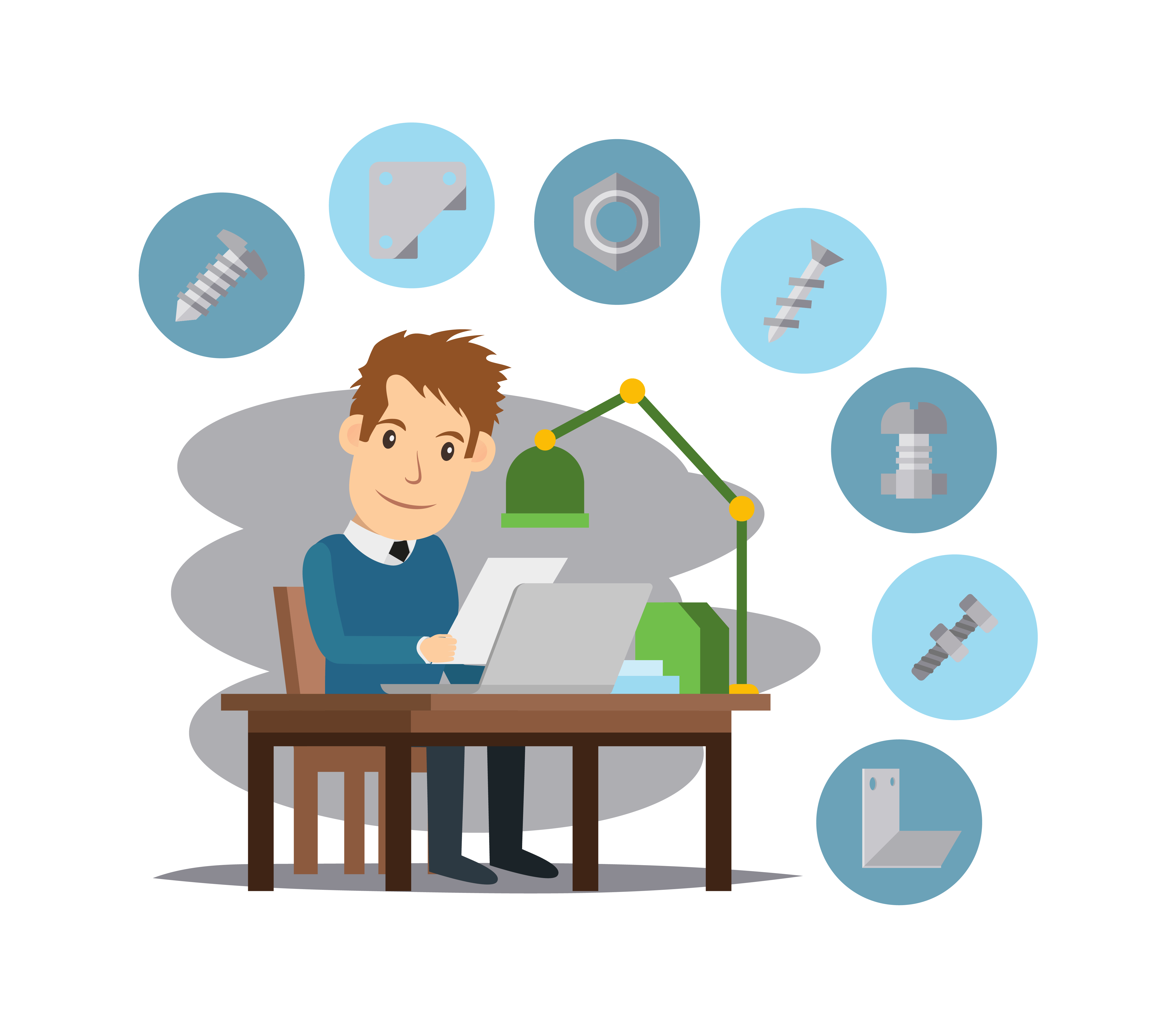
When searching 3D parts, attributes are helpful but not always enough for an accurate search. The more attribute data that is stored in part files, the more accurate a search will be. However, searching for 3D parts without a geometry search makes no sense at all.
Every good parts management system worth it’s salt has a geometry search or shape search technology as well as part attributes. Having more search features makes filtering search results easy and fast.
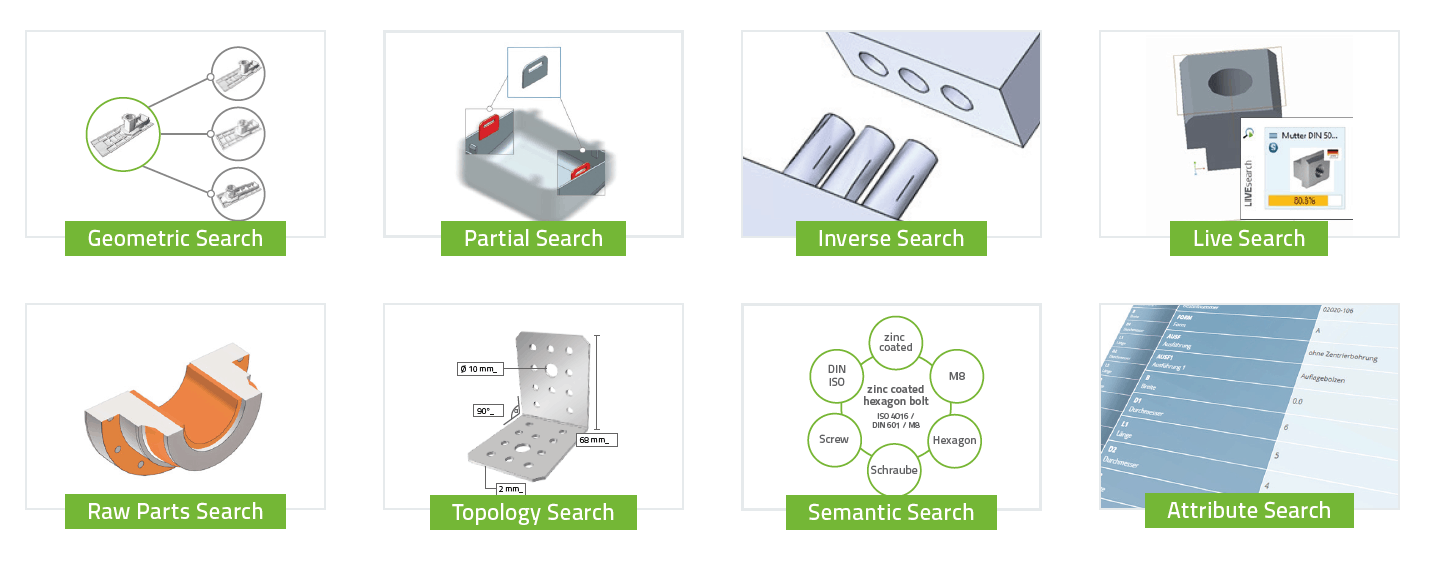
Trying to reuse parts without a parts management system is like trying to find a specific bolt in a random pile of parts. Put another way; it’s like trying to find a needle in a haystack. You may find what you are looking for eventually, but not efficiently.
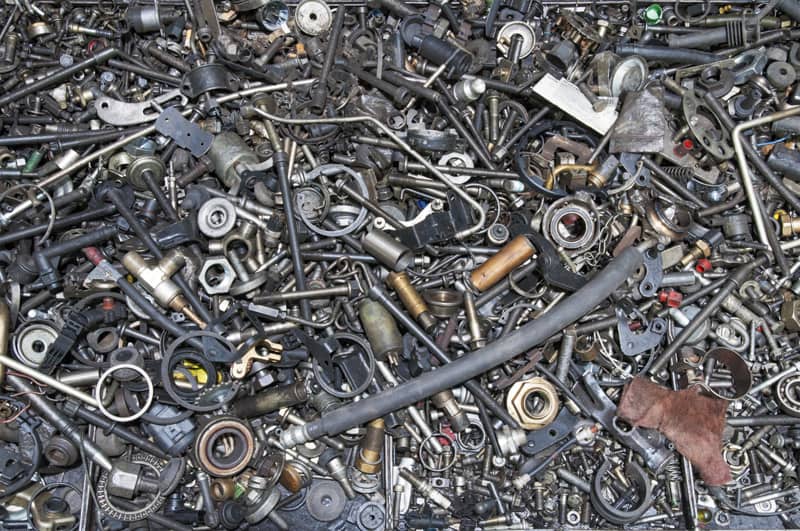
A parts management system brings the power of a Google-like search to a company’s parts and preferred supplier parts. It makes it easy to find pre-approved standard parts for reuse even if the part was created by someone in a different location or a different division within an enterprise. The best parts management tools provide catalogs of supplier parts that are up-to-date and provide native CAD files.
A parts management system lets engineers find the CAD data they need across the entire enterprise without leaving their CAD workflow.
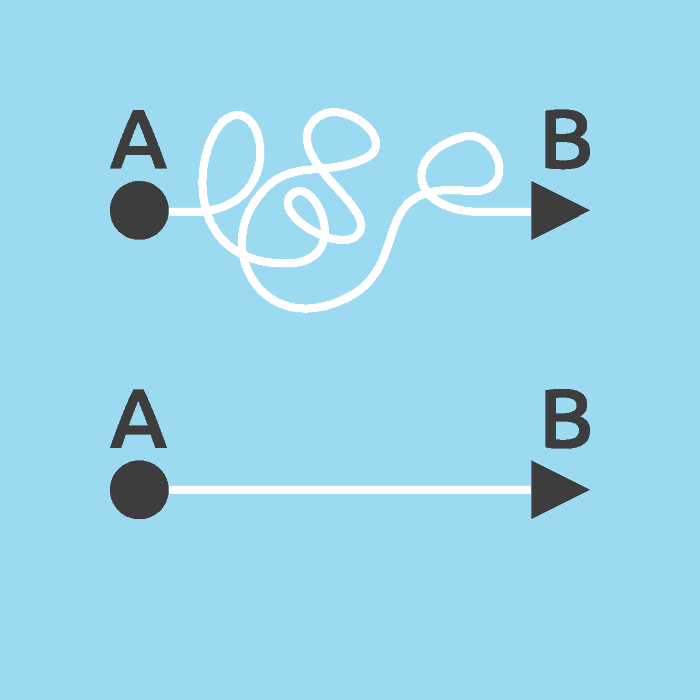
Enterprise Digital Part Standardization

When an engineering department is reusing parts, it’s just the beginning of the value of part standardization. Every department and division that implements a reuse policy compounds the cost savings.
The Reuse Method, with a parts management system in place, fosters interdepartmental collaboration. Organizational adoption provides a method and a means for departments to communicate and work together towards shared company goals.
What happens when engineers are using, and reusing parts that have already been approved by purchasing and supply chain management? Better designs, in less time, at the lowest cost.
Want help implementing The Reuse Method? Download the Engineering Reuse Time Savings Calculator. After getting your results, follow the link in the calculator to schedule a free reuse strategy assessment with one of our consultants.
Learn More: Get These Free eBooks
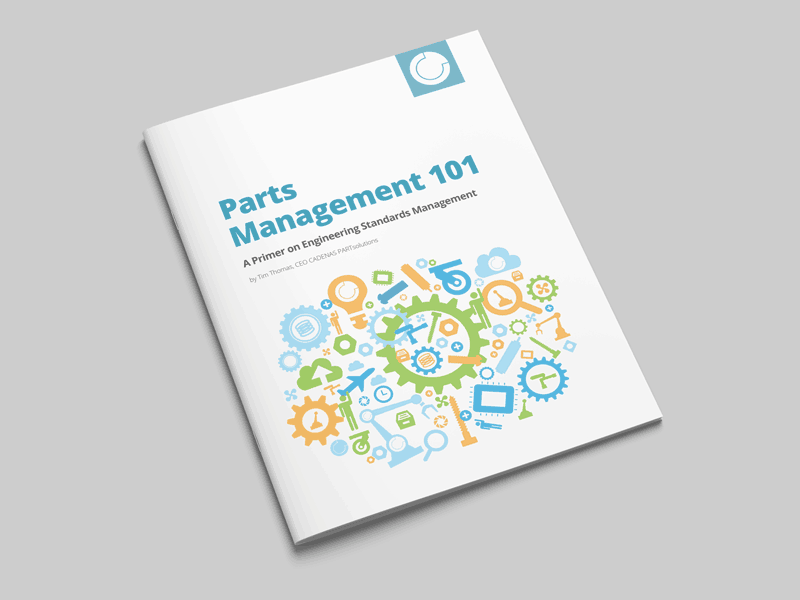
Parts Management 101
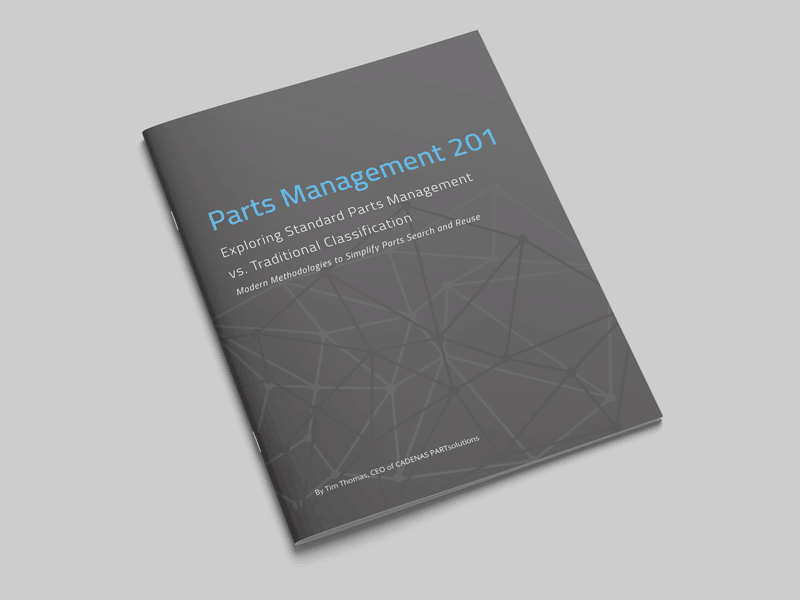
Parts Management 201
